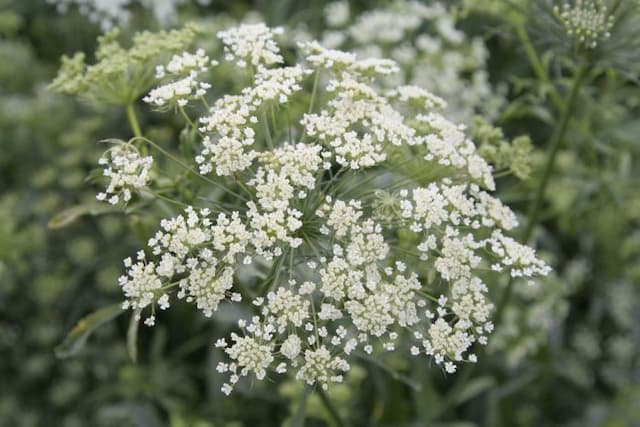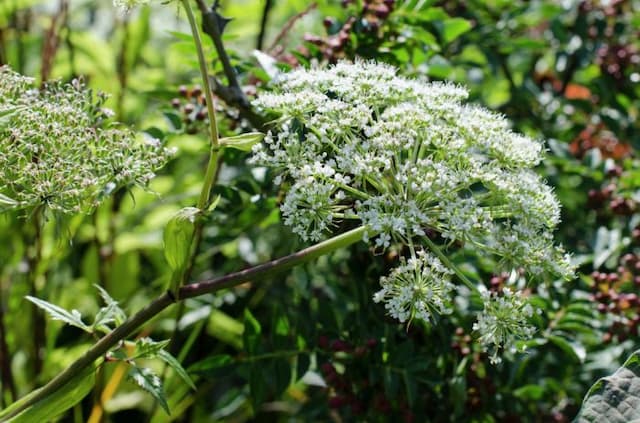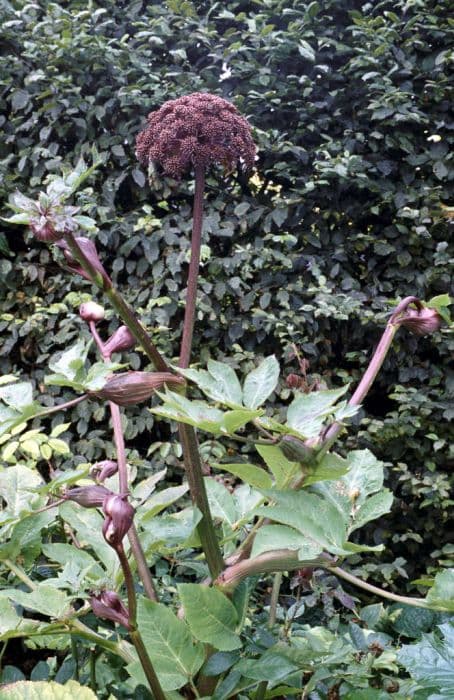Great masterwort Astrantia major 'Florence' (PBR)

ABOUT
Astrantia major 'Florence' is a perennial plant notable for its distinctive and charming flowers. The blossoms are composed of a pincushion-like central cluster of tiny, delicate flowers surrounded by a starry collar of bracts, which give them a somewhat lacy appearance. These bracts range from pale pink to a richer, mauve-pink hue, creating a soft contrast against the deeper tones of the inner flowers. The foliage of 'Florence' is equally attractive, with deeply lobed, palmate leaves that have a serrated edge. These leaves are lush and typically a bright green color, forming an attractive mound that cradles the flower heads gracefully. The leaves generally remain attractive throughout the growing season, providing a nice backdrop for the floral display. Adding to its visual appeal, Astrantia major 'Florence' has sturdy stems that hold the flowers well above the clump of foliage, giving them an airy, floating effect within a garden setting. The plant's beauty and structure make it an excellent choice for borders, cottage gardens, or as part of a naturalized planting, where its unique flowers and pleasing foliage can be admired. Its flowers are also prized for their longevity in cut-flower arrangements, bringing a touch of wildflower charm to bouquets.
About this plant
 Names
NamesFamily
Apiaceae
Synonyms
Great Masterwort, Masterwort Florence
Common names
Astrantia major 'Florence' (PBR)
 Toxicity
ToxicityTo humans
Astrantia major, commonly known as Masterwort, is not typically known for being poisonous to humans. There is little information suggesting that Masterwort contains toxic compounds that would cause illness if ingested. However, as with any plant, individual allergies or sensitivities could possibly lead to adverse reactions if the plant is handled or ingested. If you suspect poisoning from any plant, it is essential to seek medical advice.
To pets
Masterwort is not known to be toxic to pets. It doesn't appear on common lists of plants that are poisonous to dogs, cats, and other animals. As with humans, pets can sometimes have unexpected reactions to plants, and individual animals might experience mild symptoms if they have a sensitivity or allergy to the plant. If a pet ingests a large amount of Masterwort and shows signs of illness, it is important to contact a veterinarian.
 Characteristics
CharacteristicsLife cycle
Perennials
Foliage type
Deciduous
Color of leaves
Green
Flower color
Pink
Height
2 feet (60 cm)
Spread
1 foot (30 cm)
Plant type
Herb
Hardiness zones
5
Native area
Europe
Benefits
 General Benefits
General Benefits- Attracts Pollinators: 'Florence' is known to attract bees and butterflies, which aid in pollination and help maintain a healthy ecosystem.
- Aesthetic Appeal: The plant has unique pincushion-like flower heads with a soft pink hue that can add visual interest to gardens and landscapes.
- Drought Tolerance: Once established, it has good drought tolerance, making it suitable for gardens in drier climates.
- Low Maintenance: It requires minimal care once established, making it an excellent choice for gardeners looking for plants that do not need much attention.
- Long Flowering Period: 'Florence' enjoys a lengthy blooming season, often from early summer to early autumn, providing long-lasting garden color.
- Cut Flowers: The flowers can be used in floral arrangements and are known to have a good vase life, making them popular amongst cut-flower enthusiasts.
- Deer Resistance: The plant is generally resistant to deer, which makes it a good choice for gardens in areas where deer are a common problem.
- Cold Hardy: It is relatively cold hardy, meaning it can survive in cooler climates and return year after year.
- Versatile Planting Options: Suitable for planting in borders, cottage gardens, or informal garden settings, providing flexibility in garden design.
 Medical Properties
Medical Properties- This plant is not used for medical purposes.
 Air-purifying Qualities
Air-purifying QualitiesThis plant is not specifically known for air purifying qualities.
 Other Uses
Other Uses- Flower Arrangement: Astrantia major 'Florence' is often used for adding texture and delicate detail in cut flower arrangements, both fresh and dried. Its lasting quality makes it a favorite choice for florists.
- Photography Prop: The intricate blossoms of Astrantia major 'Florence' make it an attractive subject for macro and nature photographers looking to capture the complexity and beauty of plant life.
- Dye Production: Although not commonly used for dye, the petals and seeds may have potential to be used as a natural source of dye for fabrics or artwork.
- Scented Gardens: While the scent is not overpowering, Astrantia major 'Florence' can contribute to the overall aroma of a garden designed for sensory stimulation, such as a scented or therapeutic garden.
- Artistic Inspiration: The unique star-shaped flowers can serve as an inspiration for artists and designers, possibly influencing patterns in textiles, wallpaper, or other decorative arts.
- Garden Themes: This plant can be used in thematic gardens, such as a 'Starry Night' theme, where the flower's shape can play into the overall aesthetic.
- Educational Tool: The complex structure of the flowers can be used for educational purposes, such as teaching botanical illustration or explaining plant reproduction to students.
- Culinary Garnish: While not traditionally edible, flowers may be used as a decorative, non-toxic garnish on special dishes for an elegant touch.
- Wedding Decor: Due to its delicate appearance and longevity when cut, Astrantia major 'Florence' is a viable option for wedding bouquets, centerpieces, and decorations.
- Butterfly and Bee Gardens: This plant can form part of a butterfly or bee garden, as it is attractive to these pollinators thereby supporting biodiversity.
Interesting Facts
 Feng Shui
Feng ShuiThe Great Masterwort is not used in Feng Shui practice.
 Zodiac Sign Compitability
Zodiac Sign CompitabilityThe Great Masterwort is not used in astrology practice.
 Plant Symbolism
Plant Symbolism- Mystery: The complex star-like shape of Astrantia flowers lends itself to notions of mystery and intrigue.
- Protection: In the language of flowers, Astrantia can represent protection, possibly due to its sturdy structure and resilience in the garden.
- Unity: The tight cluster of florets in the center of the bloom suggests unity and togetherness, making it a symbolic gesture for strength in bonds.
 Water
WaterGreat Masterworts require consistent moisture, especially during dry spells, to keep their soil evenly moist. It's best to water these perennials about once a week with enough water to saturate the soil to the root level, which can mean roughly 1 to 1.5 gallons depending on the size of the plant and environmental conditions. Avoid overhead watering to reduce the risk of leaf diseases; instead, apply water directly at the base of the plant. During particularly hot or windy weeks, you might need to increase the frequency to ensure the soil doesn't dry out. Conversely, reduce the amount of water during cool, wet periods to prevent waterlogging.
 Light
LightGreat Masterworts thrive best in partial shade conditions, where they receive some sunlight but are protected from the harsh afternoon sun. An ideal spot is under the canopy of open trees or on the north side of a building where they can enjoy sunlight during the cooler parts of the day. However, they can also tolerate full sun in cooler climates, as long as they are provided with ample moisture.
 Temperature
TemperatureGreat Masterworts are hardy and can withstand temperatures as low as 0°F and as high as about 85°F without damage. The ideal temperature range for these plants is between 60°F to 75°F. They perform well in temperatures common to many temperate regions and should be protected from extreme heat or frost to maintain their health and blooming capability.
 Pruning
PruningPrune Great Masterworts to encourage bushier growth and more blooms. Removing spent flowers, a practice known as deadheading, will promote continuous blooming throughout the season. Cut the stems back to the base in late fall or early spring before new growth begins. Generally, annual pruning is sufficient to keep the plant healthy and aesthetically pleasing.
 Cleaning
CleaningAs needed
 Soil
SoilGreat Masterwort 'Florence' prefers a soil mix that is rich in organic matter, well-draining, and moist. A combination of garden soil, compost, peat, and perlite or sand works well for this plant. The ideal pH for this soil mix should be slightly acidic to neutral, ranging from 6.0 to 7.0.
 Repotting
RepottingGreat Masterwort 'Florence' does not require frequent repotting and can typically be repotted every 2-3 years. It's important to repot when the plant shows signs of becoming root-bound or when the soil's fertility has declined.
 Humidity & Misting
Humidity & MistingGreat Masterwort 'Florence' prefers a moderately humid environment but is quite adaptable and does not require specific humidity levels to thrive.
 Suitable locations
Suitable locationsIndoor
Ensure rich soil, indirect light, and consistent moisture.
Outdoor
Plant in partial shade, enrich soil, and ensure even moisture.
Hardiness zone
4-7 USDA
 Life cycle
Life cycleThe Astrantia major 'Florence' (PBR), commonly known as Masterwort 'Florence', begins its life cycle as a seed which germinates in spring, given damp and cool conditions. Seedlings develop into a rosette of palmate leaves, and as the plant matures, it forms a clump with multiple stems. The first blooms may appear in late spring to early summer, presenting pincushion-like flowers surrounded by bracts, in shades of dusky pink. After flowering, seeds are produced and can be dispersed, potentially leading to new plants if conditions allow. Over winter, the plant may die back to the ground in colder climates, conserving energy in its root system. In spring, new growth emerges from these roots, continuing its perennial life cycle.
 Propogation
PropogationPropogation time
Spring to early summer
Astrantia major 'Florence', also known commonly as Great Masterwort, is typically propagated by division. The best time to propagate this perennial is in the spring or early fall when the plant is not in active bloom. To propagate by division, carefully lift the entire plant with a shovel, ensuring a good portion of the root system remains intact. Gently tease apart the plant's clumps into smaller sections, each with roots and shoots. Replant the divided sections at the same depth they were growing at previously, spacing them about 12 to 18 inches (approximately 30 to 45 centimeters) apart to allow room for growth. Water the new divisions thoroughly to help establish them. This method of propagation helps to rejuvenate old clumps while increasing the number of plants in your garden.









